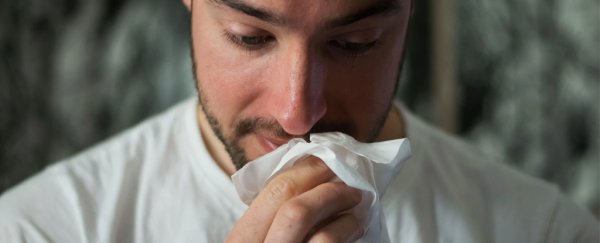There's still a lot we don't know about the coronavirus that has caused a pandemic of a new disease called COVID-19. That includes what the symptoms are and how varied they might be.
The most common distinctive symptoms of COVID-19 are a dry cough, fever, and difficulty breathing.
Though many people have no symptoms at all – despite being highly contagious – studies suggest a significant proportion of people show other symptoms first, such as diarrhoea or loss of smell and taste.
Here are 10 less-discussed symptoms of COVID-19.
Digestive issues like diarrhoea and nausea may be a more common symptom than previously thought
Digestive problems have been increasingly linked to coronavirus infections, but research is mixed on how common a symptom it is. About one in 10 coronavirus patients experience some sort of gastrointestinal symptoms, including diarrhoea and nausea, Business Insider previously reported.
A study in The Lancet reported that only 3 percent of Chinese patients experienced diarrhoea. About 5 percent of people experience nausea, according to a report from the World Health Organisation.
New research suggests that number may be higher than previously thought, and up to half of patients may have digestive issues along with respiratory symptoms.
Usually, those patients also soon develop more common symptoms like difficulty breathing, fever, or cough – only about 3 percent of cases studied had digestive symptoms alone, the researchers said.
Malaise and confusion are atypical symptoms
In a recent case report on a Washington nursing home, nearly one-third of the residents tested positive for the coronavirus, but half had no symptoms, and a few patients had unusual symptoms like malaise, a general sense of discomfort, illness, or uneasiness.
In some cases, COVID-19 may present as malaise, disorientation, or exhaustion.
This is among the most commonly reported atypical symptoms, often alongside other more frequently reported signs like cough or fever. Fatigue, which frequently accompanies other symptoms, is uncommonly reported in the absence of more prevalent symptoms.
The pandemic, quarantines, and social distancing can also cause added stress and anxiety.
These and other psychological factors could result in similar symptoms, psychotherapist Ilene Cohen wrote for Psychology Today, so it's important not to panic if you feel tired or uneasy.
Severe confusion or an inability to wake up or be alert can be warning signs, according to the Centres for Disease Control and Prevention, and people who experience those symptoms, especially with other critical signs like bluish lips, trouble breathing, or chest pain, should seek help immediately.
Chills or muscle aches occasionally accompany COVID-19
Aches and chills can be symptoms of many illnesses, including the flu, but coronavirus patients have reported them. It's not clear how prevalent these symptoms are, but about 11 percent of people studied reported chills, and 14 percent reported muscle aches, according to the WHO report.
These could be early signs of more severe symptoms or the only indication of a mild infection.
If you experience these, take additional precautions to self-isolate from other people, get plenty of rest and fluids, and contact a doctor, the Mayo Clinic said.
Headaches and dizziness may also be signs of a viral infection
According to the study in The Lancet, about 8 percent of COVID-19 patients reported headaches.
Dizziness has also been reported in some cases – frequent dizzy spells or very severe or abrupt bouts of dizziness could indicate a more serious health risk, according to the Cleveland Clinic.
Again, there are many explanations for such broad symptoms, so having one or more does not necessarily mean you're sick with COVID-19.
The CDC offers a free online self-checker to help assess whether your symptoms and circumstances indicate a coronavirus infection.
Runny nose is rarely a sign of coronavirus – it's more indicative allergies or a cold
A minority of COVID-19 patients experience nasal congestion or a runny nose – less than 5 percent of people experience these symptoms, according to the WHO report.
And sneezing isn't linked to the coronavirus at all. If you have either of these issues, it's much more likely another malady, such as allergies or a cold.
A sore throat occasionally accompanies a coronavirus infection, but again, it's more often a sign of a common flu or cold.
This article was originally published by Business Insider.
More from Business Insider:
